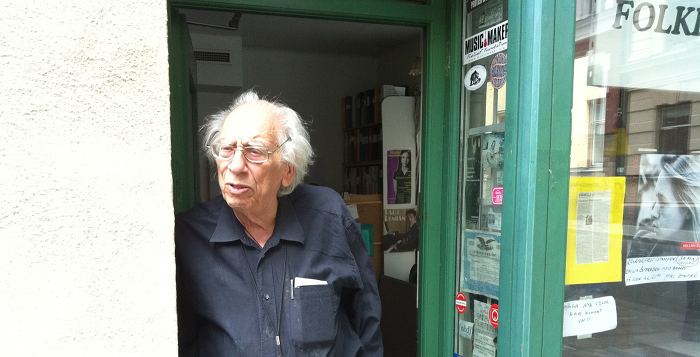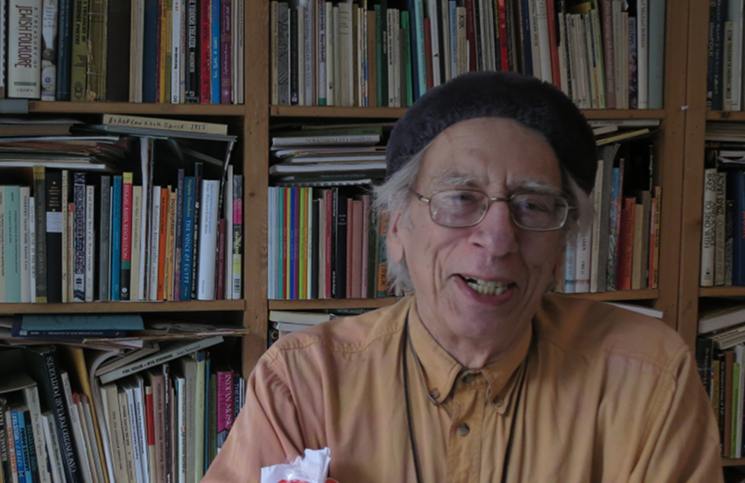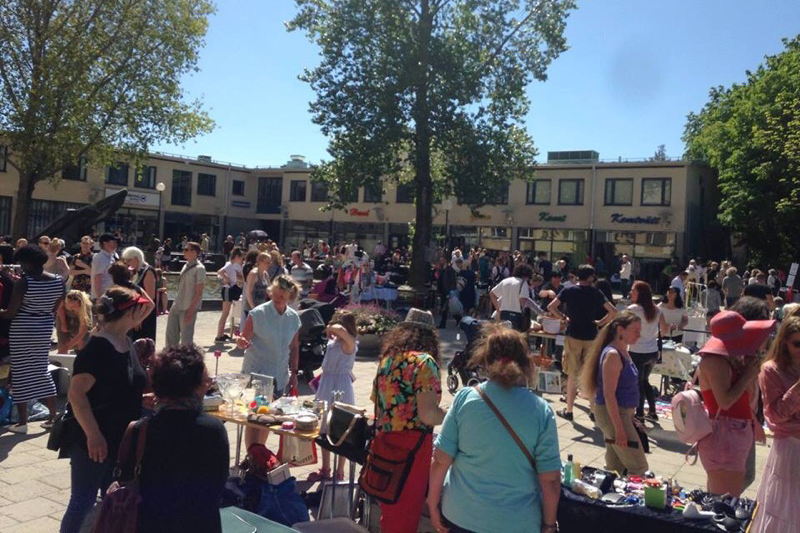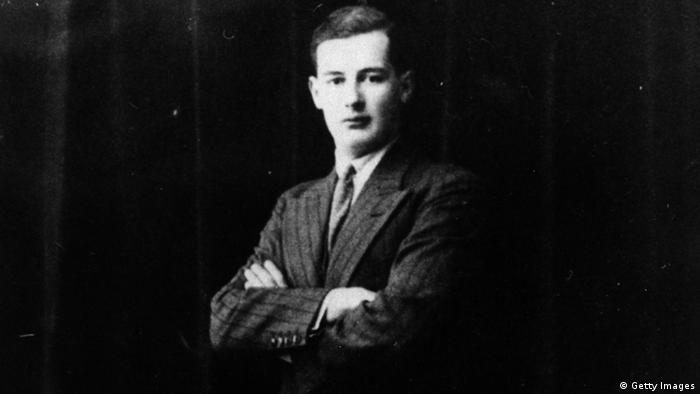Izzy Young is extraordinary in all manner of ways but perhaps most famously for having put on Bob Dylan’s first ever concert in 1961. And perhaps most amazingly because now, at 86 years old, his energy hasn’t waned at all and he is still working every day putting on concerts at his unique store in Stockholm.
I will spend the rest of this article convincing you of his greatness – but don’t just take my word for it – you can meet the man himself at one of his rare poetry readings, where as well as reciting some of his own beat flavoured poetry he will no doubt read one of the songs that Bob Dylan wrote especially for him. Although Izzy would tell you his first love is poetry, he is most famous for his role in the New York folk music scene of the 1960s…
Greenwich Village
Izzy owned and ran The Folklore Centre from 1957 – 1973. The small shop in Greenwich Village was the de facto head quarters of the folk scene that spawned the careers of Bob Dylan, Joni Mitchell and Tim Buckley, to name but a few.
Folk musician Dave Van Ronk, who was the inspiration for the recent Coen Brothers movie Inside Llewyn Davis, described the Folklore Centre in his autobiography The Mayor of Macdougal Street:
“It was a place where you could buy folk music records, books and accessories. But more than anything else it became a sort of clubhouse for the folk scene. Izzy was the switchboard: if anything was happening to anyone on the scene, Izzy would find out about it and broadcast it to the world.”
Izzy became good friends with many of the musicians hanging around the village, including Bob Dylan. In fact he organised the young folk singer’s first ever concert. And Dylan devotes a number of pages in his 2004 autobiography Chronicles to Izzy, describing the Folklore Centre as “the citadel of Americana folk music,” and says:
“Izzy was very sardonic and wore heavy rimmed glasses and spoke in a thick Brooklyn dialect. Izzy was always a little rattled over something or other. He was sloppily good-natured. In reality, a romantic.”
Now 86 years old, and spending every single day in the Stockholm version of the Folklore Centre, Izzy still perfectly fits Dylan’s description.
Swedish folk
Izzy left New York for Stockholm in 1973 and has been here ever since. Perhaps like most expats, the reasons for Izzy’s move are complex and can’t be put down to one single thing. When asked why he moved here Izzy responds;
“I can’t answer that completely.”
One of the reasons he gives though was because “Sweden saved my life.” Like a number of Americans who emigrated around the same time it seems Izzy, a proud leftist (though he hates communists), was disillusioned with American politics and of course the Vietnam War.
Izzy had always been involved in political activism and suggests that had he stayed in America his involvement with the anti war campaign would have put his life at risk.
Perhaps the most significant reason though for moving to Stockholm was a love of Swedish folk music.
“It was all Pete Seeger’s fault,” Izzy jokes about his great friend, the legendary folk singer, who sadly died in January this year.
In the late 1960s Pete invited two Swedish violin players to America who, according to Izzy, Pete had “gone nuts about when on tour in Sweden.”
Izzy already knew a bit about Swedish music through his love of square dancing.
“The most popular dance,” he says, “was the hambo, a Swedish couples dance, which I fell in love with. I had no thoughts of Sweden at the time but this dance stuck with me.”
Izzy also became a big fan of Pete Seeger’s Swedish violinists and the two Swedes would begin to regularly visit New York and stay at Izzy’s place.
“Being tall and blonde they were very popular with all my short dark Jewish girlfriends” Izzy adds.
Soon Izzy began visiting his new friends regularly in their home country. By this time Izzy had a French girlfriend and it seems like many expats here realise, Sweden was a great place for them to have a baby. Just ten months after moving to Stockholm they had a baby daughter.
“There was no baby in New York, no baby in France but we sure had a baby in Sweden,” Izzy enthuses.
First Swedish impressions
During his first visit to Sweden, Izzy stayed at his violinist friend’s house. After a couple of days of recovering from jet lag he was awoken at 6am to attend the Santa Lucia festival at the local school. He describes his first Swedish experience:
“I was still sleeping! And then in this big long room, everyone is drinking coffee and eating bulle (buns) and then someone makes a speech about how nice it is to be spending this time with the family. I thought, could you imagine the chances of Americans doing that at 6am!”
“There was nothing to see, just ordinary people talking. But it was nice. And there is nothing more beautiful than hearing Swedish kids singing.”
It was during this first visit that Izzy also got his first Swedish language lesson. Izzy was being provided for with great generosity by his hosts so after a while he decided to go to the bakery and buy some cake for everyone.
“My friends had two kids,” he explains, “So they said take the kids with you but whatever you do don’t buy them anything that says vispad grädde (whipped cream). So we go to the bakery and what do the kids ask for but cakes with whipped cream. ‘Ingen vispad grädde’ (no whipped cream) I said to them, and learnt my first three Swedish words.”
When he moved here permanently Izzy enrolled in Swedish for Immigrants. He loves languages and can still get by in Yiddish, as well as French and German. And Swedish, though he recounts the common expat experience with learning Swedish, “people just want to talk English with me.”
Despite this concern, Izzy reads the Swedish newspapers daily.
“I think the Swedish language is a very good language,” he adds. “There is a whole different rhythm in the Swedish language. And they have much clearer words than English. The Swedes don’t kid around.”
When he first moved here some 40 years ago Izzy says there was nothing he didn’t like about Sweden.
“I’d walk in the park near the library, they keep building new parks all the time, unbelievable, and I saw three or four bums. Their shoes, their jackets were all better than mine and I thought, what a country!”
There are some aspects of Sweden though that Izzy is not a fan of. When he first arrived, he was bemused by people standing at red lights at pedestrian crossings.
“Even if there were no cars. Twelve people would just stand there and not cross!”
Izzy also likes to talk a lot, and complains Swedish people don’t talk enough. He also generally sees things as good or bad and hates the Swedish concept of lagom.
But he thinks Swedish people are nice and also likes the fact there are no bars on windows like there are in New York, although he thinks this is beginning to change in the more expensive areas of Stockholm. He also likes the cleanliness of the city and the good pension “that keeps me alive.”
He also loved Swedish films and went to the theatre a lot. And of course he went to concerts.
“I Like Swedish music,” he says.
“I came here to hear Swedish music. Everything that American music has to say is open and obvious, with simple compositions and melodies. You get it right on the spot. Swedish music takes a longer time to get the whole idea and it is more intellectual in a way. You really have to think about it, but it grows on you.”
Cultural contributions
Izzy first opened the Stockholm iteration of the Folklore Centre (renamed the Folklore Centrum) on Sveavägen, before eventually moving it to its current location on Wollmar Yxkullsgatan.
“It was probably because Pete Seeger wrote a letter of recommendation to the Swedish government that I was allowed here,” Izzy says. “Pete wrote that if Izzy Young is allowed to live in Sweden he will contribute much to Swedish culture.”
And from the Folklore Centrum Izzy spent the next 40 years promoting folk music in Sweden through regular concerts and via a 20-30 page newsletter in which he listed festivals, dances and courses taking place up and down the country. The newsletter had around 2,500 subscribers.
“I came here to put on all types of music in one place. Before I moved here I had seen that people only promoted the things in their own local areas. I was the first one to bring everything together,” he says.
Despite his connections to some of the most famous names in music (he still gets sent free tickets for Dylan concerts in Stockholm), Izzy has never made much money. This is probably, as Dylan wrote, because Izzy is too much of a romantic. But he doesn’t seem to mind too much.
“If I have enough money in my pocket to buy the paper and get a cup of coffee, I am happy,” he says.
And he is still going strong and can be found in his Folklore Centrum almost every day, where he sells a handful of second hand records and books from the windows. If you go in, you will meet an extraordinary man. He undoubtedly has a heart of gold and often quips;
“I am still a fun loving Jewish boy who grew up in the Bronx, New York and never changed or tried to.”
Maybe just take some advice from Bob Dylan. In his song Talking Folklore Centre, which Dylan wrote for Izzy in the early 60s, and which Izzy now has stashed in a Stockholm bank vault, Dylan writes “Do like most people do. Walk in, walk around, walk out.”

Or you can meet Izzy at the concerts he regularly hosts at the Folklore Centrum – also always intimate and special evenings with the highest quality of musicianship. They are listed regularly on the Konserter page of the website!
Images: Danny Chapman/Rebecca Martin












